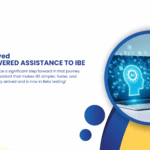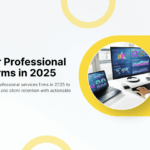In a subscription-based Cloud/SaaS environment, you earn retention every day..
Due to Low Switching Cost Customer Retention is very Important for Any Saas Application.
Customer retention is the lifeblood of any successful SaaS business. While acquiring new customers is important, retaining existing ones is significantly more cost-effective and profitable. Studies consistently show that increasing customer retention rates by just 5% can increase profits by 25% to 95%. Let’s explore proven strategies that can help your SaaS application build lasting customer relationships.
List of Customer Retention Strategies we adopted At ibe.net : A Data-Driven Approach
1. Smooth and intuitive Onboarding Experience
First impressions matter tremendously in SaaS. A smooth, engaging onboarding process can dramatically improve retention rates.
Implement progressive onboarding: Don’t overwhelm new users with every feature at once. Guide them through core functionalities first, then gradually introduce advanced features as they become more comfortable with your platform.
Set up quick wins: Design your onboarding to help users achieve their first success as quickly as possible. Whether it’s completing a first project, generating a first report, or inviting a team member, these early victories create positive associations with your product.
Personalize the journey: Use data from signup forms or initial surveys to customize the onboarding experience based on user role, industry, or stated goals. A marketing manager and a developer will have different needs from your platform.
2. Deliver Continuous Value Through Product Excellence
Your product must consistently solve real problems for your customers. This seems obvious, but it requires ongoing commitment.
Maintain product-market fit: Regularly validate that your product still addresses your customers’ evolving needs. Markets change, competitors emerge, and user expectations shift. Stay ahead through continuous research and iteration.
Focus on performance and reliability: Nothing drives churn faster than a buggy, slow, or unreliable product. Invest in infrastructure, testing, and monitoring to ensure your application performs flawlessly.
Innovate based on feedback: Create systematic ways to collect, analyze, and act on customer feedback. Users who see their suggestions implemented feel valued and invested in your product’s success.
3. Building a Proactive Customer Success Program
Customer success teams should prevent problems before they arise, not just react to them.
Implement health scoring: Develop metrics that indicate customer health—login frequency, feature adoption, support tickets, etc. Proactively reach out to accounts showing warning signs before they consider churning.
Schedule regular check-ins: Don’t wait for customers to come to you with problems. Establish regular touchpoints to ensure they’re getting value, address concerns, and identify opportunities for deeper engagement.
Create success milestones: Define what success looks like for different customer segments and create programs to help them achieve those milestones. Celebrate their achievements to reinforce the value they’re receiving.
4. Leverage Data and Analytics
Understanding user behavior through data is essential for retention optimization.
Track engagement metrics: Monitor which features users engage with most, where they struggle, and where they find value. Use this information to guide product development and customer success efforts.
Identify churn patterns: Analyze customers who have churned to identify common patterns or triggers. Did they stop using certain features? Did they fail to reach specific milestones? Use these insights to intervene earlier with at-risk customers.
Segment your audience: Not all customers are the same. Create segments based on behavior, needs, or value, and tailor your retention strategies accordingly.

5. Create an Exceptional Support Experience
Quality customer support can transform a frustrated user into a loyal advocate.
Offer multiple support channels: Different customers prefer different communication methods. Provide options including live chat, email, phone support, and self-service resources.
Reduce response times: Speed matters. Implement systems and staffing to ensure quick responses, especially for paying customers or critical issues.
Build a comprehensive knowledge base: Invest in self-service resources including documentation, video tutorials, FAQs, and community forums. Many customers prefer finding answers themselves.
6. Implement Strategic Communication
Thoughtful, relevant communication keeps your product top-of-mind without being annoying.
Send value-driven emails: Share tips, best practices, feature updates, and industry insights. Every communication should provide genuine value, not just promotional content.
Use in-app messaging: Contextual messages within your application can guide users, announce relevant features, or prompt specific actions at the right moment.
Personalize communications: Use customer data to send targeted, relevant messages based on user behavior, role, or stage in the customer journey.
7. Offer Flexible Pricing and Packaging
Rigid pricing can force customers to churn when their needs change.
Create upgrade paths:
Make it easy for customers to move to higher tiers as their needs grow. This prevents churn from customers who’ve outgrown their current plan.
Offer downgrade options: Sometimes keeping a customer at a lower tier is better than losing them entirely. Provide options for customers experiencing budget constraints or reduced needs.
Be transparent about value: Clearly communicate the ROI of your product. Customers who understand the value they’re receiving are less price-sensitive.
8. Monitor and Optimize the Customer Lifecycle
Retention efforts should span the entire customer journey.
Address the critical early period: The first 30-90 days are crucial. Focus intensive resources on ensuring new customers activate key features and experience value quickly.
Re-engage dormant users: Implement win-back campaigns for inactive users. Sometimes customers get busy or forget about your product—a well-timed reminder can bring them back.
Conduct exit interviews: When customers do churn, learn why. This feedback is invaluable for preventing future churn.
9. Continuously Measure and Improve
Retention optimization is an ongoing process, not a one-time project.
Track key metrics: Monitor metrics like Monthly Recurring Revenue (MRR) retention, customer retention rate, Net Revenue Retention (NRR), and customer lifetime value.
Run retention experiments: Test different approaches to onboarding, communication, pricing, or features. Use A/B testing to identify what works best for your specific audience.
Benchmark against industry standards: Understand how your retention metrics compare to industry averages for your type of SaaS, customer segment, and pricing model.
Call to Action
Client success is never a one-step effort. It’s a continuous journey. It requires a solid strategy that starts with smooth onboarding and continues through every stage of the customer lifecycle. From delivering product quality and providing great support to offering flexible pricing and consistently driving value, true client success relies on ongoing, long-term engagement.



